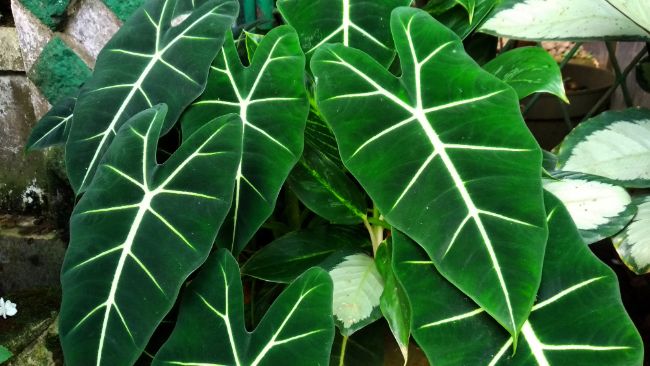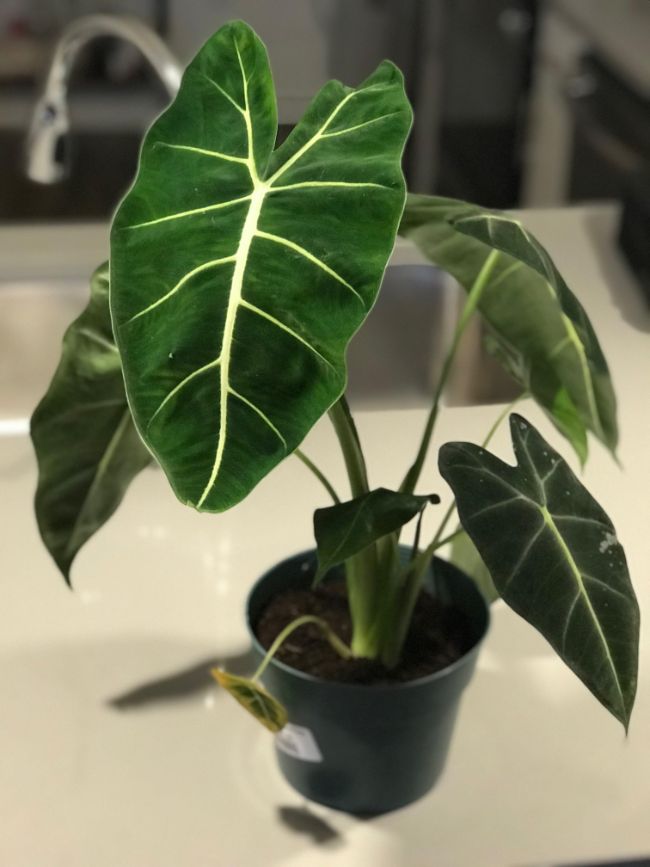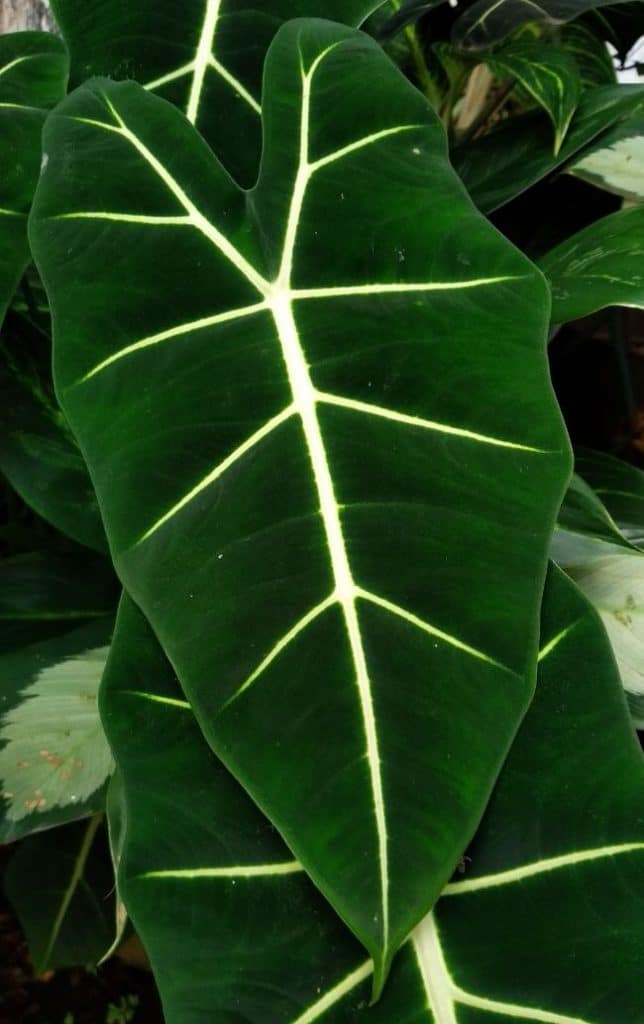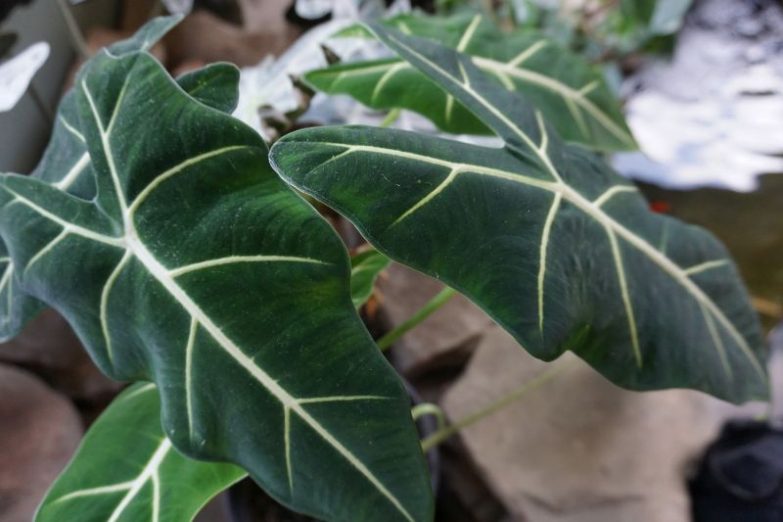Alocasia micholitziana ‘Frydek’, also known as Alocasia Green Velvet is a stunningly beautiful variety of Alocasia that has grown massively in popularity over the last few years. Like other Alocasias, keeping it thriving and looking its best can be a bit of a challenge. This article will cover all you need to know about Alocasia Frydek care to keep yours looking great.
To provide good Alocasia Frydek care, provide bright indirect light, high humidity, and well-draining potting mix that stays lightly moist. Keep your Alocasia Frydek in temperatures of 65°F (18°C) to 85°F (29°C) and fertilize monthly when actively growing.
This article will look at each aspect of Alocasia Frydek care in turn and cover how to deal with all of the common problems. Let’s start with a little more detail about basic care.
Alocasia Frydek Care Summary
| Scientific Name | Alocasia micholitziana ‘Frydek’ |
| Common Name | Alocasia Frydek, Green Velvet Alocasia |
| Origin | The Philippines |
| Light Requirements | Bright, indirect light. Avoid more than 1-2 hours of direct sunlight. |
| Watering | Water once the top 1-2 inches of soil is dry. Water use varies widely during the year, so monitor the plant, rather than watering on a schedule. |
| Soil | Well draining, but fertile. I recommend a mix of 60% peat, 30% perlite, and 10% compost or worm castings. Here are some ideal pre-made alocasia soil mixes. |
| Temperature | Will thrive in temperatures of 65°F (18°C) to 85°F (29°C). Avoid temperatures below 60°F (16°C) as this can trigger dormancy. |
| Fertilizer | Alocasia Frydek benefits from regular fertilizer while actively growing. I use a balanced water-soluble fertilizer every month. |
| Humidity | Try to maintain humidity above 50%. Leaves can develop brown tips or edges if humidity is too low. |
| Flowering | Rarely indoors. Will produce an unimpressive cream/white spadix with a light green spathe. |
| Pruning | Prune old foliage, but otherwise no pruning necessary. |
| Propagation | Propagate by division of larger plants in spring or early summer. |
| Re-Potting | Only repot when showing signs of being rootbound. Does better in a smaller pot, so be careful not to increase pot size too much when repotting. |
| Diseases and Pests | Prone to root rot due to watering issues. Sap sucking pests can also be attracted to Alocasia Frydek. |
| Toxicity | Toxic to humans and pets if ingested. |
| Where To Buy | Buy Alocasia Frydek online at Etsy (I buy most of my houseplants from Etsy). |
Light Requirements
Alocasia Frydek does best in bright, indirect light. It can be quite sensitive to light intensity and can suffer when it either gets too much or too little light. Aim to place your Alocasia Frydek somewhere in your home where the light is bright enough to cast a shadow but is out of direct sunlight.
More than 1-2 hours of direct sunlight per day will normally result in leaf scorching and brown edges or tips on the leaves. Considering the beauty of the leaves is the key attraction, I would advise keeping your Alocasia Frydek completely out of direct sunlight if possible.
In insufficient light, Alocasia Frydek will grow very slowly, taking a long time to grow new leaves. Alocasias also have a tendency for the lower leaves to turn yellow as they age, so a plant that is not growing sufficiently can soon look sickly and sparse. Alocasia are also more prone to overwatering in low light conditions as the soil will take longer to dry out.

Watering
Alocasias can be one of the trickiest houseplants to get watering just right. They have thick, water storing stems and petioles, which gives them some succulent properties, but they do not tolerate drought at all. They are also quite susceptible to overwatering, so the trick is to keep the soil lightly moist, without ever letting it get soggy or dry out excessively.
During the growing season, I recommend soaking the soil thoroughly once the top 1-2 inches of soil feels dry. Make sure to let the excess water drain fully, to ensure the roots are not sitting in soggy soil.
Alocasia Frydek care can be tricky due to their susceptibility to both overwatering and underwatering. There are a few things you can do to prevent most problems.
- Do not overpot. Use a pot that is just big enough for the plant but no more. This will help the soil dry quicker and reduce the risk of overwatering.
- Make sure the pot has adequately sized drainage holes to allow any excess water to drain out of the pot easily.
- Use a very well-draining potting mix. A mix of 60% peat, 30% perlite, and 10% compost is a good mix that I find works well. However, there are plenty of good options. Read more about choosing and making potting soil here.
- Check your plant every few days for signs it needs to be watered. Check the moisture of the soil, the weight of the pot and check the plant for any signs of over or underwatering. Water when you determine it is needed, not on a schedule.
Alocasias will grow much more slowly in winter, and may enter a period of dormancy. During these times, their water requirements will decrease markedly. If you detect growth slowing, or that the soil is staying wet for longer after each watering, you may want to switch to “sip watering” for a few months.
Rather than soaking the soil each time the plant needs watered, add a relatively small amount of water. This will provide sufficient water for the plant, while preventing it from sitting in soggy soil.
This isn’t an ideal way to water houseplants normally, as it usually leads to accumulation of salts in the soil, that would otherwise by washed out by thorough watering.
You will need to monitor your Alocasia Frydek quite closely to determine when to water it to balance the risks of overwatering and underwatering. Read this article I wrote for more advice about deciding when to water your houseplants.
Choosing Soil For Alocasia Frydek
Alocasia Frydek does best in potting mix that drains very well, but is able to retain a little moisture, to keep the soil lightly moist most of the time. The also benefit from some added organic material as their nutrient requirements are higher than many other houseplants.
I prefer to use a mix of 60% peat, 30% perlite and 10% compost or worm castings. As long as your soil has similar properties to this mix, then you can use many combinations of materials.
Some people prefer to avoid peat-based potting mix due to concerns re: sustainability. I often use coconut coir as a great substitute, but you can read more about the options here.
Temperature
Alocasia are accustomed to growing in tropical forest understorey, so temperatures of 65°F (18°C) to 85°F (29°C) are ideal. Thankfully, this matches the temperatures in our homes very nicely.
You should be careful to avoid temperatures below 60°F (16°C) as this can trigger dormancy. This will result in your Alocasia Frydek dying back significantly, although it will recover once growing conditions become more favorable.
The biggest temperature problem with Alocasia Frydek care is hot and cold drafts. Leaky windows in winter, or heating or cooling vents near your plant can cause major problems. You may see lower leaves yellowing and dying, or even the whole plant drooping. Consider moving your plant to a more sheltered spot if the plant is struggling despite meeting its other care requirements.

Fertilizing Alocasia Frydek
Alocasia Frydek needs more fertilizer than many houseplants. I normally apply a fast-acting, water-soluble fertilizer every 3-4 weeks while the plant is actively growing. I use a general-purpose, balanced 20-20-20 fertilizer that I dissolve in water at half the recommended strength.
If you are using a formulation specifically for houseplants, you can safely use it as per the instructions. There are plenty of fertilizers to choose from that will be suitable for Alocasia Frydek, but a balanced preparation or one that has more nitrogen than phosphorus and potassium is likely to produce better results.
Some people prefer to use organic fertilizer, such as worm castings or compost, and these can be great options, although it is more difficult to know how much you need to add.
The most important thing is to provide sufficient nutrients for your Alocasia Frydek without overdoing it and causing signs of nutrient toxicity. Read my guide to fertilizing houseplants for more information.
Humidity
Alocasia Frydek will benefit greatly from being kept in higher humidity conditions. Generally, if you keep humidity levels above 50%, then your plant should have no issues.
In lower humidity, you may start to see brown leaf edges and brown tips. Considering the beautiful foliage is the main appeal of Alocasia Frydek, keeping humidity levels up is a must.
I would strongly recommend getting a digital hygrometer, which is thankfully very inexpensive. I have several of these in my home and they allow me to tell at a glance what the current humidity levels are, as well as the maximum and minimum humidity since the hygrometer was last reset.
If humidity in your home is below 50%, you can try the following methods to increase it.
- Group your houseplants together. The increased transpiration from the foliage will increase local humidity levels.
- Place your Alocasia Frydek on a humidity tray. All you need is a wide tray with small pebbles scattered on the bottom. Rest the pot of your Alocasia Frydek on the pebbles and add water to the tray to a level just below the top of the pebbles. This way the plant pot will not be sitting in water. As the water in the humidity tray evaporates, local humidity around your Alocasia Frydek will increase.
- Use an electric humidifier to really boost humidity levels. Many of these can monitor and maintain a specific humidity level, but you do need to refill the water reservoir every now and then.
Read more about how to increase humidity for your houseplants in this article.
Pruning
Alocasia Frydek care comes with minimal pruning requirements. The lower leaves of Alocasia Frydek will eventually turn brown, shrivel and droop. This is a natural process, and as long as the plant is producing new leaves faster than it is losing old ones, then all is well.
You can prune off dead lower leaves as required to keep your Alocasia Frydek looking beautiful.
Propagation
The best way to propagate Alocasia Frydek is by division of larger plants. This is best done in spring or early summer, when the plant is growing strongly.
Alocasia Frydek is quite a fragile plant, so it is best to only try to propagate larger, healthy plants.
- Gently remove your Alocasia Frydek from its pot. You can gently squeeze the pot to loosen the plant and try to slide it out of the pot.
- Remove excess soil from around the roots. This will help you see the best place to separate your Alocasia Frydek.
- Alocasia Frydek has a clumping growth habit, and the rhizome will periodically produce a new stem from the rhizome that can easily be separated.
- Try to gently tease the rhizome apart as much as possible, and then use a sharp blade to cut the rhizome to divide the plant.
- Each division can be potted separately in moist potting mix as discussed earlier in this article. You should make sure to keep the soil lightly moist and provide moderate lighting, to ensure the newly divided plants do not suffer excess stress.
Read my article about propagating houseplants for more information.

Repotting
Alocasia Frydek does best in a pot that is quite small relative to the size of the plant. Generally, you shouldn’t repot it until there is evidence of it becoming root-bound.
These signs can include roots growing out of the bottom of the pot, growth slowing despite good care, or the soil drying out rapidly after watering.
When repotting, choose a pot that is only about 1 inch larger than the previous pot. Take the opportunity to check the roots for any signs of problems. Any diseased or damaged roots should be removed.
Before putting your Alocasia Frydek in its new pot, gently remove excess soil from the roots and carefully loosen the roots if they are in a tight ball.
I generally prefer to water my Alocasias 1-2 days before I plan to repot them. This makes sure the plant is in good condition, and also makes the soil and roots easier to work with.
After repotting, I tend to only water very lightly. Sometimes it takes the roots a week or two to return to normal function after repotting, and watering heavily can increase the risk of root rot setting in. Read my article about repotting rootbound houseplants to learn more.
Diseases
The main diseases to be aware of are those associated with overwatering. Bacterial leaf spot and root and crown rot are the most common issues, but all can be prevented by ensuring your choice of pot, soil and watering practices are suitable.
If you think your Alocasia Frydek may have a disease, read my article about common houseplant diseases to find out what it is and how to treat it.
Pests
Alocasia Frydek care is quite often complicated by sap-sucking pests. Thrips, mealybugs, scale, spider mites and aphids all seem to love Alocasias.
Take precautions when you bring your new Alocasia Frydek home to ensure it is not harboring any pests. I would advise quarantining your plant away from your other houseplants for one week to ensure no hitchhiking pests have been brought home with your plant.
Get into the routine of checking the top and underside of the leaves every few days to check for pests. Early identification can make treating the pests and preventing damage to your plants much easier.
Toxicity
Alocasia Frydek is moderately toxic to people and pets if ingested. The plant tissue contains calcium oxalate crystals which cause localized irritation. If ingested, they can cause pain and swelling of the mouth and digestive tract.
If you have small children or pets, it is best to keep your Alocasia Frydek out of reach.
Alocasia Frydek can also cause skin irritation for some people if touched. You should consider wearing gloves when handling this plant, particularly if you have sensitive skin.
Why Is My Alocasia Frydek Drooping?
Alocasia Frydek will droop due to a number of stressors. Overwatering, causing root rot, and underwatering resulting in wilting are the most common causes of an Alocasia Frydek drooping. Other causes include temperature stress, transplant stress, pests, disease, or excessive fertilizer.
If your Alocasia Frydek is drooping, you should take a methodical approach to identifying the problem. Look at each aspect of care in turn, to try to identify the problem. The treatment is entirely dependent on what the underlying issue is.
Why Are The Leaves On My Alocasia Frydek Turning Yellow?
Yellowing leaves on Alocasia Frydek is often due to overwatering, where it tends to start with the lower leaves first. Excessive direct light will cause the leaves to become paler and yellow, often with a patchy distribution. You may also see brown, crispy tips and leaf edges.
Other sources of stress can cause yellow leaves, such as nutrient toxicity due to excess fertilizer use, drafts, or temperature stress. Sometimes, if an Alocasia Frydek is just generally unhappy, the lower leaves will progressively turn yellow at a rate faster than it is producing healthy new leaves.
This is a major warning sign that something is wrong, so it should prompt you to look at the care conditions of your Alocasia Frydek and work out what needs to be adjusted.

